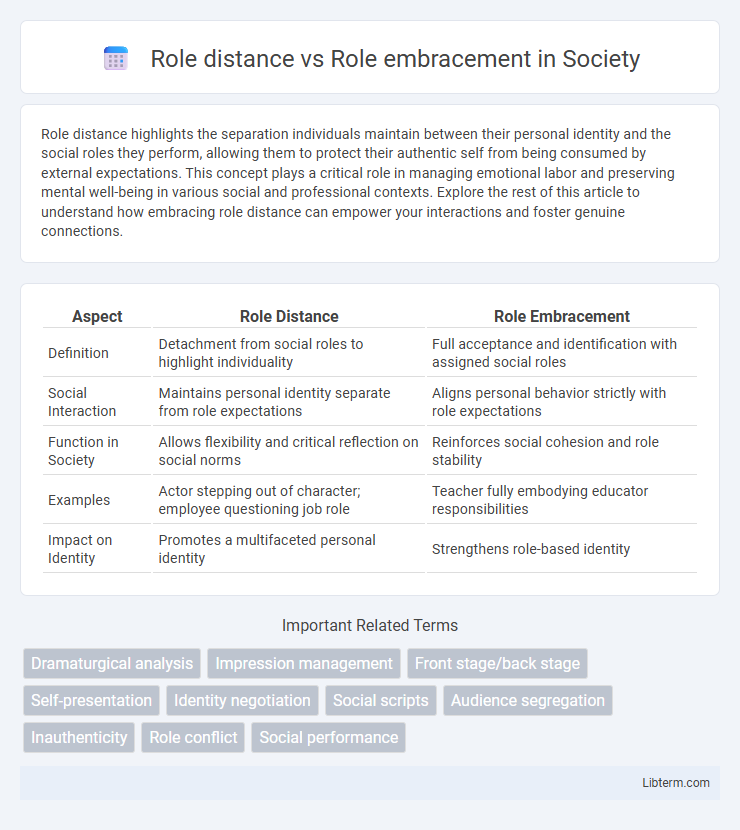Role distance highlights the separation individuals maintain between their personal identity and the social roles they perform, allowing them to protect their authentic self from being consumed by external expectations. This concept plays a critical role in managing emotional labor and preserving mental well-being in various social and professional contexts. Explore the rest of this article to understand how embracing role distance can empower your interactions and foster genuine connections.
Table of Comparison
| Aspect | Role Distance | Role Embracement |
|---|---|---|
| Definition | Detachment from social roles to highlight individuality | Full acceptance and identification with assigned social roles |
| Social Interaction | Maintains personal identity separate from role expectations | Aligns personal behavior strictly with role expectations |
| Function in Society | Allows flexibility and critical reflection on social norms | Reinforces social cohesion and role stability |
| Examples | Actor stepping out of character; employee questioning job role | Teacher fully embodying educator responsibilities |
| Impact on Identity | Promotes a multifaceted personal identity | Strengthens role-based identity |
Understanding Role Distance and Role Embracement
Understanding role distance involves recognizing how individuals emotionally detach from their assigned social or professional roles to maintain personal identity and avoid role strain. Role embracement occurs when individuals fully internalize their roles, integrating the expectations and responsibilities into their self-concept, which can enhance performance but may also lead to role engulfment. Balancing role distance and role embracement is critical for psychological well-being and effective role management in social interactions.
Historical Perspectives on Social Roles
Historical perspectives on social roles reveal a tension between role distance and role embracement, where individuals either detach from societal expectations or fully internalize prescribed behaviors. Classic sociological theories by Erving Goffman highlight role distance as a means to assert individuality within rigid social structures, whereas Durkheim's functionalism emphasizes role embracement as essential for social cohesion and stability. This dynamic interplay shapes the evolution of social identities across cultures and epochs, reflecting shifts in power, status, and collective norms.
Key Theories Explaining Role Behavior
Role distance underscores the psychological separation individuals maintain from their social roles, as emphasized by Erving Goffman's dramaturgical analysis, highlighting how people manage impressions by differentiating themselves from role expectations. In contrast, role embracement involves full identification and internalization of the role, supported by identity theory, which posits that individuals align their self-concept with role norms to achieve coherence and social approval. Symbolic interactionism further explains these behaviors by focusing on the dynamic negotiation and interpretation of roles through social interactions and meaning-making processes.
Defining Role Distance in Social Contexts
Role distance in social contexts refers to the intentional separation individuals create between themselves and the social roles they perform to express autonomy or reject imposed identities. This concept highlights how people manage impression and identity by signaling that their role-playing does not fully define their authentic self. Unlike role embracement, where individuals fully accept and internalize their social roles, role distance emphasizes detachment and self-assertion within social interactions.
Characteristics of Role Embracement
Role embracement involves fully accepting and internalizing assigned responsibilities, demonstrating high commitment and proactive engagement in tasks. Individuals exhibiting role embracement show strong identification with their roles, leading to enhanced motivation and consistent performance aligned with organizational goals. This deep involvement fosters adaptability, accountability, and a positive attitude toward role-related challenges.
Factors Influencing Role Distance and Embracement
Role distance and role embracement are influenced by factors such as individual personality traits, cultural norms, and situational context. Cognitive dissonance and self-concept clarity play a critical role in determining whether an individual maintains emotional detachment or internalizes the role. Social expectations, power dynamics, and organizational culture also significantly impact the degree of role embracement or distancing.
Impacts of Role Distance on Personal Identity
Role distance influences personal identity by allowing individuals to separate their authentic self from their social roles, reducing conformity and fostering self-awareness. This separation can protect against role strain and burnout, enhancing mental well-being and promoting greater flexibility in identity formation. However, excessive role distance may lead to feelings of alienation and a fragmented sense of self, impacting social relationships and emotional stability.
Social Consequences of Role Embracement
Role embracement often leads to enhanced social cohesion and increased trust within groups due to the individual's strong identification with social roles. Embracing roles can result in positive social validation and a clearer sense of belonging, reinforcing group norms and expectations. However, excessive role embracement may also cause social rigidity, limiting personal flexibility and potentially fostering exclusion of those who deviate from prescribed roles.
Role Distance vs Role Embracement: Real-World Examples
Role distance is evident when employees maintain a clear boundary between their personal identity and workplace expectations, such as customer service representatives who consciously avoid adopting the scripted emotional displays inherent in their roles. Conversely, role embracement occurs when individuals deeply internalize their professional responsibilities, like teachers who identify closely with their educational mission and integrate it into their self-concept. Real-world examples illustrate how role distance can serve as a protective mechanism against burnout, while role embracement often enhances job satisfaction and commitment.
Navigating Social Roles: Finding Balance
Navigating social roles requires balancing role distance, which allows individuals to maintain personal identity and boundaries, with role embracement, fostering deeper engagement and authenticity within a group. Effective social interaction hinges on recognizing when to adopt role distance to avoid stereotype traps and when to embrace roles to build trust and cooperation. Achieving this balance improves social cohesion and individual well-being by aligning external expectations with internal values.
Role distance Infographic

 libterm.com
libterm.com